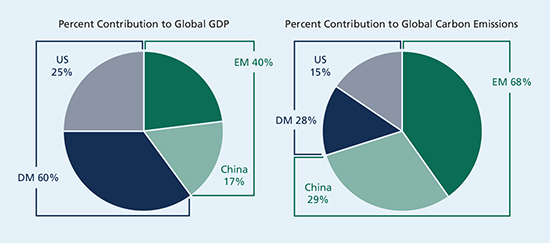Decarbonising the world

|
Written By: Jonathan Davis |
Jonathan Davis at PineBridge Investments discusses how asset owners and asset managers can help to incentivise efforts towards the goal of carbon neutrality
When it comes to combating climate change, the Paris Agreement of 2016 is clearly vital. This important framework aligns nearly 200 countries in pursuit of a critically important long-term climate goal: limiting the rise in global average temperature to 1.5 °C above pre-industrial levels. However, while the scope of the agreement is important, its terms also pose limitations on its ability to generate real progress toward its climate goals from the ground up. Actual change that delivers a meaningful reduction of greenhouse gases requires a shift in incentives for both governments and corporations to transform their operations toward the goal of carbon neutrality.
Here’s where we – and you – come in. As providers and stewards of global capital, asset owners and asset managers can take an active role in creating the incentives needed to realise the Paris Agreement’s objectives, as well as newer ones.
Another, more recent, important thrust against climate change came in May 2021, when all G7 economies committed to reach net-zero emissions by 2050.¹ That meeting also yielded the G7 Industrial Decarbonisation Agenda, an initiative to reduce greenhouse gas emissions from heavy industries such as steel, cement, and chemicals. In addition, the G7 ministers agreed to stop direct funding of coal-fired power stations in developing nations and instead focus on investing in clean-technology power.
A question of decision-making, not engineering
Making actual progress toward decarbonisation requires the demonstration that new, greener methods of industrial production, electricity generation, or agricultural harvests can be both profitable and efficient. In most cases, the necessary technology exists, so the issue isn’t one of engineering capabilities but rather financial decision-making. In that context, asset managers’ engagement with corporations on how they invest in such areas, with a direct pass-through to the investment decisions of asset managers and ultimately on the cost and availability of capital, can provide the financial incentive to shift toward lower-emission operations.
We shouldn’t expect all corporations and governments to move in synchrony toward more sustainable modes of operation, but the vanguard’s success in implementing new lower-emissions processes, with the benefit of lower funding costs, should eventually fuel a reconfiguration of industries around these new systems.
The importance of China’s carbon-cutting commitment
As forward-thinking asset managers know well, no initiatives to reduce carbon emissions can be successful without the commitment of China, the world’s largest emitter of carbon, accounting for more than 25% of global annual emissions.² China’s 14th Five-Year Plan, issued in 2021, provides its most diligent guidance with respect to curbing its climate emissions, with targets to reduce carbon emissions per unit of GDP by 18% over the next five-years and ensuring that emissions will have peaked by 2030.³ This objective isn’t only important as it relates to China’s current emissions standing; its ongoing rapid urbanisation will continue to power demand for cars, urban construction, and electricity.
The country’s efforts will focus on areas where it currently lags most advanced economies: reducing its reliance on coal, which currently accounts for 60% of China’s electricity production, and improving efficiency in its cement production, which now consumes 30% more energy per ton of cement than in advanced economies.⁴ China will also continue investing in areas where it’s already a world leader, such as in production of battery cells and other technologies that will allow China to position itself as a leading tech provider for decarbonisation efforts around the world.
Like China, EMs also need to make big moves
Emerging market (EM) investors will also take on an important role in the global reduction of carbon emissions. EMs represent 40% of the global economy⁵ and are responsible for more than 60% of global carbon emissions.⁶ China, of course, is the key contributor to the role of emerging markets within both the global economy and global carbon emissions. Just as China needs to invest in cleaner sources of electricity and greener industrial production, EMs globally have similar investment needs. Broadly speaking, EMs are dependent on foreign direct investment and global capital markets, so initiatives like the G7’s commitment to halt funding of coal-fired power stations can make a meaningful impact.
Within capital markets, EM corporate issuers experience a substantial difference in cost of capital between those rated higher and lower on environmental, social, and governance (ESG) issues, which means asset owners and asset managers can make a material impact on the incentives for EM issuers to invest in carbon-reducing technologies. Recently, we have seen a rise in EM corporate issuers taking advantage of demand for green investment and the subsequent lower cost of capital to issue sustainability-linked bonds, which have coupon step-ups directly linked to decarbonisation targets during the bond’s term.
Figure 1: Emerging markets represent 40% of global GDP and more than 60% of global carbon emissions

Source: IMF, Bloomberg, and PineBridge Investments as of 31 December 2021. Carbon emissions data for full year 2019. We are not soliciting or recommending any action based on this material. Any opinions, projections, estimates, forecasts, and forward-looking statements presented herein are valid only as of the date of this presentation and are subject to change. For illustrative purposes only.
ESG integration helps spot opportunities for alpha
Within PineBridge’s EM Debt team, we view the integration of ESG risk within our investment processes as part of our fiduciary responsibility to clients as well as our responsibility as good corporate citizens. Our investment process is driven from the bottom up, with strong fundamental credit analysis, and ESG risk is a critical part of this framework. We have identified Climate Action as one of our top priorities because global commitments to decarbonisation will have a transformative impact on economies, industry-wide business models, and individual issuers’ profitability. Our approach to ESG integration focuses equally on identifying beneficiaries of carbon initiatives and avoiding market segments that are likely to be left behind in the move toward a carbon-neutral world.
Many investors believe EM economies are typically commodity exporters that will be challenged by commitments to reduce carbon emissions. First, it’s important to understand that while a number of net commodity-exporting economies are within emerging markets, so are just as many net commodity-importers. Second, it’s also important to understand that while decarbonisation will cause demand for fossil fuels to drop, a number of other commodities play an integral role in the green technologies that will foster decarbonisation and therefore will experience structural increases in demand.
The goal is environmental and financial sustainability
The decarbonisation of our planet is vital to its sustainability, and the coordinated commitment of governments, financiers, and corporate entities toward that goal is essential to its success. In our role as asset managers, we have a responsibility to contribute to environmental sustainability efforts and a responsibility to ensure that our clients’ portfolios are positioned for financial sustainability as well.
With so much of this story yet to be written, we have identified three must-have attributes within our ESG framework that will enable our investments to both promote decarbonisation and to profit from it. First, we find it essential to prioritise an integrated, forward-looking ESG trend within our analysis of ESG risk. Second, we must be prepared to look to the future and not necessarily exclude exposure to carbon, but rather to include exposure to entities that are moving toward lower-carbon processes. Third, we must maintain an engagement framework to identify and encourage issuers to make investments in green technology – investments that will make their business models not only more sustainable, but also more profitable in the carbon-neutral world of the future.
Disclosure
Investing involves risk, including possible loss of principal. The information presented herein is for illustrative purposes only and should not be considered reflective of any particular security, strategy, or investment product. PineBridge Investments is not soliciting or recommending any action based on information in this document. Any opinions, projections, or forward-looking statements expressed herein are solely those of the author, may differ from the views or opinions expressed by other areas of PineBridge Investments, and are only for general informational purposes as of the date indicated.
1. G7 Climate and Environment: Ministers’ Communique, 21 May 2021
2. Source: Bloomberg, 31 December 2020
3. Source: UN High-Level Climate Champions, 15 March 2021
4. Boston Consulting Group, 14 December 2020
5. Source: IMF and Bloomberg as of 31 December 2021
6. Source: IMF and Bloomberg as of 31 December 2021
More Related Content...
|
|
|